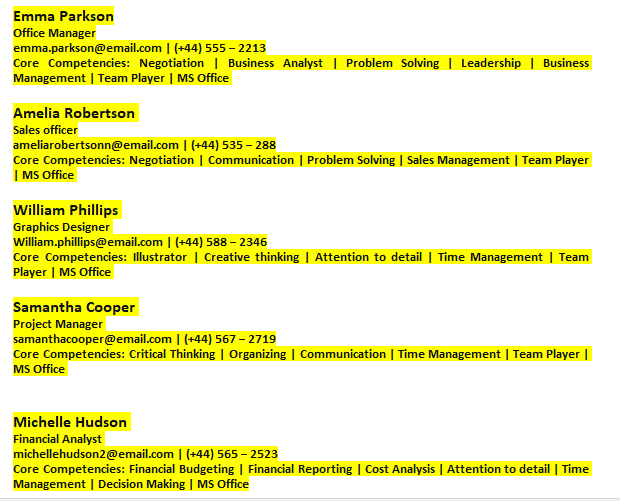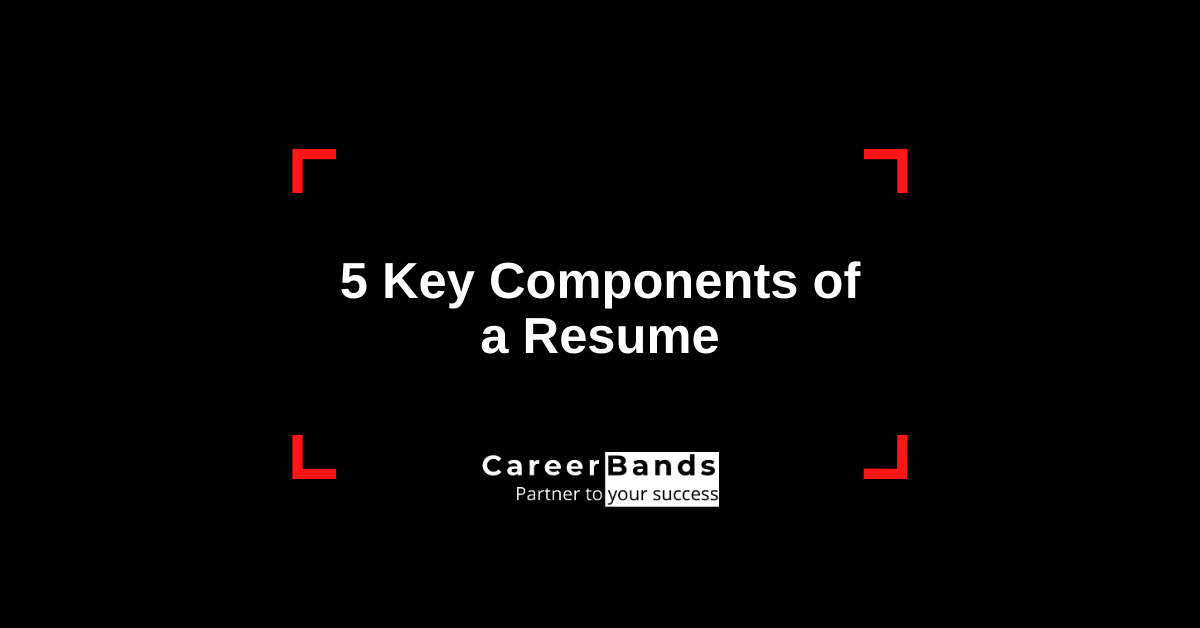A resume provides an overview of the applicant’s personal information, education section, work history, skills, and abilities based on which a hiring manager makes a hiring decision. If the relevant elements are assembled in a resume appropriately, then it would increase the probability of getting hired by the corporations. The main components of a resume are resume header, summary statement, core competencies, work history, and education. It is vital to compose these fundamental ingredients rightfully to leave a remarkable impression on the hiring manager.
What are the Key Elements of a Resume
There are 8 main components in a resume
1. Information about yourself (name, address, phone number, e-mail address)
2. Objective
3. Skills
4. Education
5. Work experience
6. Awards and recognition
7. Publications
8. Languages
Related: Resume Title Examples for Any Job
In this article, We will illustrate how to write key components of a resume.
Resume Header
A resume header is the topmost part of the resume, which contains the personal information of a candidate. It is the primary resume component that a hiring manager notices when going through the bundles of resumes. Hence, it should be marginalized, capitalized, and formatted.
It would be highly inappropriate to start a resume header from the heading of resume, which is the most common resume header error. Instead, the resume header begins from the formal name of an applicant on the top of the resume. Below the name of an applicant, the contact number, job title, email address, and social media information are stated.
The contact number used in a resume header must be active and functional as it is the prime source through which a hiring manager contacts the candidate. The job title in a resume header refers to the current job position of an applicant, which conveys a brief synopsis of the work experience of the applicant. The email address used in this column should not be unprofessional like, name@domain.com. It should rather be formal and professional. Lastly, the resume header can also contain a LinkedIn profile or blogging website. LinkedIn is the trending tool through which a manager selects a candidate. It should be kept up to date and well maintained if inscribed in the resume header.
Summary Statement
Following the resume header, a resume summary statement is the career overview of an applicant. The resume summary should be brief and attractive as it is the second-most essential component of a resume. It is required to use keywords in the summary statement to get noticed by the applicant tracking system (ATS). It provides a quick outline of the applicant’s key skills and, background.
However, to write an effective career summary statement, an applicant should assess the job description carefully and then note down his valuable and relevant skills in a precise manner. For instance,

Core Competencies Section
Core competencies are the qualifications and skills of the applicant. This section entails the skills, knowledge, certifications, and personality traits. These competencies should be attractive enough to captivate the hiring manager in making a hiring decision. Moreover, when the ATS reviews a resume it picks up the keywords instantly and forwards your resume.
Some commonly used core competencies in a resume are
Project Management, Leadership Skills, Problem Solver, Team Player, Customer Service, Negotiation, Analytical Thinking, etc.
Some examples of core competencies may be:

Employment History / Work Experience
Employment history is the central resume component, which is a prior work experience of an applicant, which comprises a detailed report of all the past jobs in order, the tenure and location of those jobs, and the responsibilities and accomplishments achieved during those jobs. This portion of a resume depicts the potential and talent of the applicant truly.
The detailed work history report usually starts with a recent job to the preliminary job including, the name and locations of the corporations that an applicant has worked for, along with the job title, and job responsibilities, followed by specified dates. Further, notable accomplishments and outstanding awards can also be featured in the work history of an applicant.
Selective keywords should be used while describing past job responsibilities, and accomplishments to get noticed by ATS or hiring manager. Moreover, adjectives and action verbs can also be used on the responsibilities and accomplishment portion to make a resume look even more appealing and captivating. For instance, “creative thinking“, “problem-solving” etc.
Education
It would be pitiful if the years of learning that an applicant puts in for his/her desired job go unaddressed by the employer. It may sound simple but writing about the education section can be critical to producing an attractive resume. This segment describes how qualified you are and the core areas of your resume, that may lead you to your desired job.
Thus, here are some guidelines that you may take notes of,
- State information in the following order: The degree you received, your major, your school, and then the year you graduated.
- Keep the description precise. Only highlight the best projects you have worked on, curriculum achievements (i.e., the highest pass mark in Financial Accounting Exam), and awards you have received.
- Always start with the highest level of education you have received.
- Delete high school education if you have graduated from college.
- Exclude the graduation date if it has been more than 5 years of receiving graduation.
However, these guidelines are subjective, but because your CV/Resume should be precise, accurate, and focused, you need these pointers to keep this crucial section updated, and appropriately for the employer to read it thoughtfully, rather than skim it all through.


